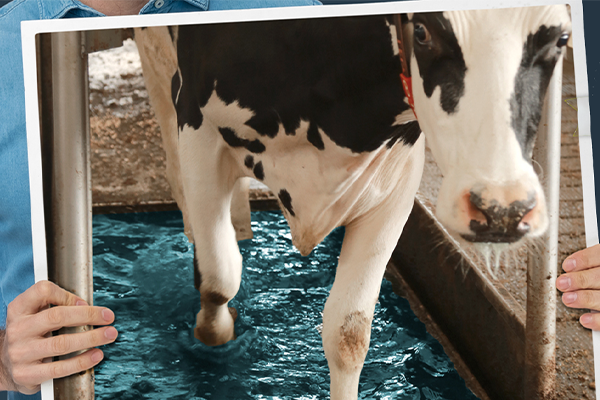If sulphates are so effective in footbaths, why are they in the ration?
- Ruminants
All dairy farmers know that the trace elements copper, manganese and zinc are essential to ensure optimal animal health. But, unfortunately, not everyone is aware that these trace elements are often added to the ration in the form of sulphates. This should be avoided, as research has revealed that sulphate sources have adverse effects on the performance of dairy cows, such as reduced fibre digestibility. Fortunately, an alternative is available.

Far from ideal
Copper and zinc sulphates are traditionally valued for their antimicrobial activity. This is why they are frequently used in footbaths to prevent claw problems, including ulcers and infections. And it explains the distinctive blue colour, typical of copper, of the disinfectant water. But this also raises an important question: if sulphates have such a powerful antimicrobial effect in footbaths, should you really be feeding them to your cows? It might seem obvious, but the answer is no. Feeding your cows trace elements in sulphate form is far from ideal.
Negative effects in the rumen
Although their low price point means that trace elements are often added to the ration in the form of sulphates, the call for alternatives is growing. And even more as these cheaper minerals appear to have detrimental effects on the performance of the animals. Sulphates are highly soluble in the rumen and therefore have a negative (antimicrobial) effect. Bacteria that contribute to fibre degradation particularly benefit from a low level of dissolved copper and zinc.
Reactivity in the feed
Sulphate trace element sources not only dissolve in a watery environment, the bonds between the metal and the ligand are weak and easily broken down. As soon as they meet water - which already happens in the mixer - free/ionized copper, manganese and zinc particles are released. This alters the taste and palatability of the feed, at the expense of the feed intake.
Moreover, simply providing trace minerals is not enough: they must also be absorbed by the small intestine after the rumen. Up to 60% reactivity of the trace element to be fed might already occur in the mixer wagon, where it reacts with nutrients and other minerals, reducing the availability for the animal. In other words, a valuable part of the calculated ration is lost straight away. In addition, even with very low levels of copper, zinc, and manganese sulphates in mineral mixes, the antimicrobial properties lead to reduced fibre digestibility.
Remove sulphates from your ration!
- Reduced fibre digestibility
- Quicker degradation of valuable vitamins and unsaturated fats
- Only a small part of the trace elements fed to the cow is absorbed
(higher proportion of valuable trace elements is excreted in the manure) - Feed is less palatable
IntelliBond: the alternative to harmful sulphates
As well as providing sulphates in the ration, an alternative that provides all essential trace elements is available on the market. IntelliBond is the most innovative and effective way of providing copper, manganese and zinc. These hydroxy trace minerals are ideally suited to fully replace sulphates. IntelliBond supports a higher energy availability from the ration and greater availability of trace elements for your dairy cows. This boosts herd health in general. In addition, it offers a responsible way to provide a lower amount of trace elements and reduce the excretion of copper, zinc and manganese in the manure.
Improved fibre digestibility
Unlike sulphate-bound trace elements, IntelliBond remains stable in the feed and in the rumen, so there is no reactivity with other nutrients. Beneficial microbes in the rumen are not affected by IntelliBond. Research using IntelliBond has shown an average improvement in fibre digestibility (NDF) of 1.7% compared with sulphate sources. This delivers a level of net energy and protein for milk production that equates to up to 0.6 kg higher milk production a day! At present, this represents a return on investment (ROI) of 1:25 (based on basic price June 2023). In addition, IntelliBond has a higher bioavailability compared with sulphates, reducing the need for these supplements.

Figure 1. Effect on fibre digestibility (NDF fraction) of IntelliBond compared with sulphates as a source of trace elements for dairy cattle.